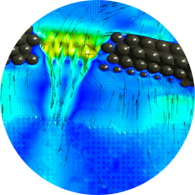Obtížně kvantifikovatelné procesy ovlivňující vodní bilanci lesních povodí
Výzkum byl zaměřen na procesy, které jsou citlivé na změny dlouhodobých srážkových a teplotních podmínek a zároveň jsou obtížně kvantifikovatelné, čímž komplikují předpověď hydrologické odezvy lesních povodí na probíhající změny klimatu. Zvláštní pozornost byla věnována procesům doprovázeným změnami skupenství, pro které hrají očekávané změny tepelného režimu klíčovou roli: (i) mrznutí a tání půdy a sněhu, (ii) evapotranspiraci, (iii) intercepci a usazeným srážkám. Z metodologického hlediska projekt kombinuje přístupy hydroklimatologického monitoringu a fyzikálně založeného numerického modelování. Při kvantifikaci složek vodní bilance byl aplikován princip tří úrovní hydrologické separace – na úrovni vegetačního krytu, půdního povrchu a půdního podloží.
The main objective of the project was to contribute to an improved understanding of the impacts of changing climate on the water balance of forest catchments of temperate zone. This was achieved by combining advanced methods of hydroclimatological monitoring and numerical modeling. The research focused on processes that are sensitive to changes in long-term patterns of temperature and precipitation, and are difficult to quantify, thus complicating the predictions of hydrological responses of forest catchments to changing climate. The catchment water balance was studied using the concept of three levels of hydrological separation – at the canopy level, at the soil surface level, and at the soil–bedrock interface.
Important contributions have been made in the following research areas:
- Implementation and validation of soil freezing/thawing model resulting in improved numerical stability (Vogel et al., 2020),
- Innovative soil surface infiltrability evaluation (Bagarello et al., 2022),
- Advanced analysis of subsurface hydraulic properties - including forest soil anisotropy derived by X‑ray CT and interfacial properties of forest soil aggregates (Beck-Broichsitter et al., EES 2022, JHH 2022),
- Combined modeling of unsaturated and saturated flow processes involving isotope-supported model calibration (Vitvar et al., 2022),
- Implementation of original modeling algorithms describing the evaporation of intercepted water and transpiration reduction due to wet canopy effects (Vogel et al., 2022),
- Catchment water balance uncertainty analysis revealing significant interannual variations of the individual water balance components (Skalová et al., 2022),
- Forest stand interception analysis involving a comparative study of canopy interception models (Kofroňová et al., 2021),
- Determination of extreme precipitation intensities from temporally aggregated time series offering more efficient precipitation extreme estimates where the precipitation sums are available in coarser time resolution (Hnilica et al., 2021).
- Analysis of the contribution of wind-driven low clouds and fog to throughfall in montane forest stands based on the composition of stable isotopes of hydrogen and oxygen (Hůnová et al., 2020).

